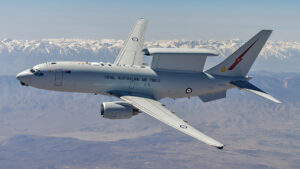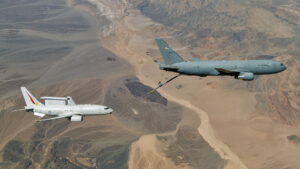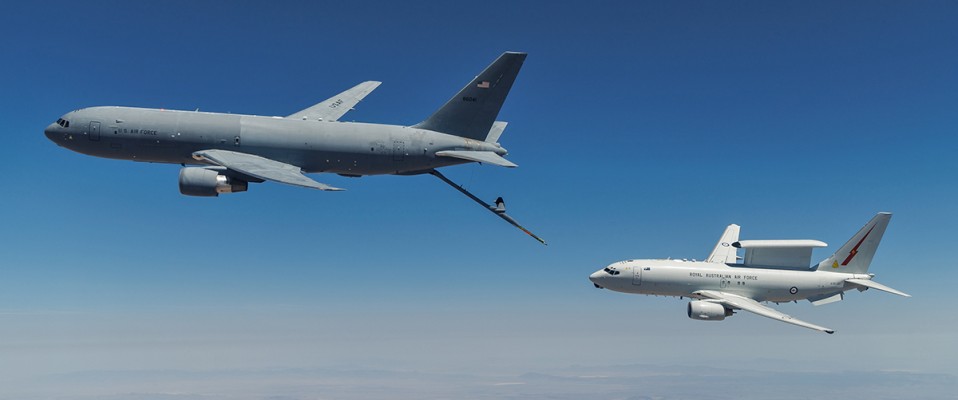WEDGETAIL SOARING OVER THE
MOJAVE DESERT.
Trilateral Test and Evaluation squadrons come together to train at Edwards Air Force Base.
Article: Jaryd Stock
Images: U.S. Air Force
In a historic first, the U.S. Air Force (USAF), Royal Australian Air Force (RAAF), and Royal Air Force (RAF) collaborated to rapidly improve global combat capability while gathering critical test data for the USAF’s future acquisition of the E-7A Wedgetail airborne early warning and control (AEW&C) aircraft.
This milestone certifies KC-46A Pegasus air-to-air refueling of the RAAF’s E-7A Wedgetail, while streamlining USAF and RAF E-7 Wedgetail certification efforts. The efforts are part of a broader vision of trilateral collaboration that identifies enhanced operational output through mutual support, shared resources, and commonality, ultimately achieving greater operational reliability through efficiencies of scale under the Enhanced Air Cooperation initiative.
The testing occurred in the United States from Edwards Air Force Base under the 418th Flight Test Squadron, Global Reach Combined Test Force. Test teams brought together a deployed RAAF E-7A Wedgetail (serial: A30-001) from No.2 Squadron based at RAAF Base Williamtown and a KC-46A Pegasus, marking the tanker’s first aerial refuelling receiver certification for a unique foreign aircraft type.
The RAAF E-7A’s ability to receive fuel from the USAF KC-46 fleet increases Australia’s combat reach by providing options beyond the traditional KC-135 Stratotanker and RAAF KC-30A Multi-Role Tanker Transport, especially now as the KC-10A Extender has been retired from USAF service.

A KC-46A assigned to the 418th Flight Test Squadron at Edwards Air Force Base positions to refuel a Royal Australian Air Force E-7A Wedgetail in the airspace near Edwards. (Air Force photo by Richard Gonzales)
While this enhanced combat capability will immediately benefit the Pacific theater, the unique partnership forged during this testing will also pay dividends as both the USAF and RAF field their own E-7 Wedgetails in the coming years.
“The RAAF is the original operator of the E-7A aircraft,” said Squadron Leader Owen Hamilton, flight commander, Australian Research and Development Unit.
“We have already tested and overcome many early challenges typical of a new platform. This unique knowledge allows us to guide our allies in the U.K. and U.S. to field their own E-7A Wedgetail capability faster.”
ARDU is the RAAF’s flight test and evaluation squadron located at RAAF Base Edinburgh near the City of Adelaide in Australia and is tasked with planing conducting and analysing the results of ground and flight testing of existing and new Air Force aircraft.
Bringing three nations together for testing presented challenges, including understanding the required processes for secure data sharing between the KC-46 and E-7A, two platforms that had never interfaced. Boeing, the mission partner and KC-46 program office, assisted the 418th FLTS with breaking down these barriers.
“Sharing data and understanding how to dissect and utilize the information is just as important as the actual test certification,” said Maj. Matthew Daughtery, global reach test pilot, 418th FLTS. “There are no benchmarks or precedents for aligning these systems. The USAF and RAAF use different rules and nomenclatures. A key part of developmental testing is to find a path to success. Where there’s a will, there’s a way!”
An RAF representative also participated in the testing with No.56 Test and Evaluation Squadron from RAF Waddington participating in the trilateral testing phase, as the RAF will soon operate a variant of the E-7 Wedgetail. This hands-on experience provided critical early exposure as they begin their own flight test campaign as the RAF’s E-7’s will have to utilise the boom on USAF tankers as their own tanker aircraft are exclusively fitted for house and drouge system (WARP Pods).
“This test event reflects the joint collaboration and interoperability between our three nations,” said Squadron Leader Angus Lilly, RAF test pilot. “We will soon begin flight testing our own E-7A aircraft, and this early collaboration will help us field our capability more efficiently.”

Maj. Jeremy Rohn, USAF 418th FLTS, SQNLDR. Owen Hamilton, RAAF ARDU and SQNLDR Angus Lilly, RAF 56 T&ES, pose in front of a E-7A Wedgetail aircraft at Edwards Air Force Base, CA. (Air Force photo by Daniel Kelley)
The robust testing over the Mojave Desert signals a new era in networked airborne early warning and control capability. Lessons learned are already informing future test planning as the RAF and USAF prepare to transition to E-7 Wedgetail operations.
Further, the KC-46 now has a data baseline for certifying unique foreign aircraft, a shining example of testing efficiency.
“The U.S. is demonstrating the impact of our trilateral engagement through this testing, with the ultimate goal of full interoperability for global defence,” said Michael Baker, E-7A chief of developmental test for the USAF. “E-7A interoperability will allow joint forces to focus on the fight, not on aircraft ownership. This also lays a path for future cooperation to enhance the E-7A for the future.”The USAF expects to start testing its first E-7A later this decade.
The RAAF have already been working extensively with the USAF and RAF AEW&C squadrons, as the exchange program of USAF and RAF personnel to No.2 Squadron have been in place for the last few years.
During Exercise Pitch Black 2022 the USAF began embedding Airmen into No.2 Squadron through the Military Personnel Exchange Program in preparation of replacing the aging E-3 Sentry Airborne Warning and Control System.
For the USAF, the program goes beyond familiarity with the Aircraft. Integrated members also work with RAAF members to solve problems and make operations more efficient and effective gaining a deeper understanding of utilising the capabilities the Wedgetail provides.
This experience will be critical to USAF AEW&C crews with the military service expected to introduce the Wedgetail in 2031.

A Royal Australian Air Force E-7A Wedgetail soars over Southern California. (Air Force photo by Richard Gonzales)

A KC-46A assigned to the 418th Flight Test Squadron at Edwards Air Force Base positions to refuel a Royal Australian Air Force E-7A Wedgetail in the airspace near Edwards.(Air Force photo by Richard Gonzales)
Jaryd Stock is based in Sydney Australia. He has been a die-hard aviation enthusiast from a young age when he was chauffeured around by his father to various airshows and airports around Australia. At his first Airshow he witnessed the awesomeness of a General Dynamics F-111C and immediately fell in love with aviation.
Jaryd picked up a camera at a young age and has never looked back. He now combines photography and writing to highlight “Downunder” aviation; especially U.S. DoD units. Jaryd uses Nikon cameras and lenses.


